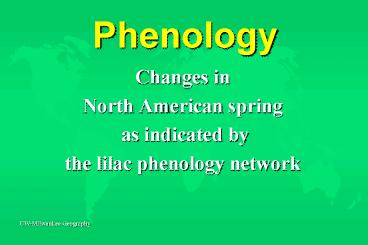Phenology - PowerPoint PPT Presentation
1 / 33
Title:
Phenology
Description:
First bloom date (SI models) Last frost date in ... SI First Bloom 1961-2000 Slope. UW-Milwaukee Geography ... Simulated phenology (SI first bloom dates) ... – PowerPoint PPT presentation
Number of Views:82
Avg rating:3.0/5.0
Title: Phenology
1
Phenology
- Changes in
- North American spring
- as indicated by
- the lilac phenology network
2
Research Contributions
- Phenology analyses from D. Wolfe
- Phenology data from J. Caprio
- Climate data from USA National Climatic Data
Center - NSF Grants ATM-9510342, 9809460, and 0085224
3
Research Contributions
- Delayed Moving Average (DMA) Satellite start of
season (SOS) technique developed by Bradley Reed
and colleagues - Seasonal Midpoint NDVI (SMN) Satellite start of
season (SOS) technique developed by Michael White
and colleagues
4
Terrestrial Biosphere Dynamic Change Detection
- Satellite Phenology
- Cloned Species Phenology
- Native Species Phenology
- Simulated Phenology (Models)
5
Satellite Phenology
- Advantages
1) Global coverage
2) Integrated signal - Limitations
1) Short period-of-record
2) Cloud cover interference
3) Interpretation issues
4) Small set of measures
6
DMA NDVI Start of Season 1995(Reed et al., mean
day 74, March 15th)
7
SMN NDVI Start of Season 1995 (White et al.,
mean day 124, May 4th)
8
Cloned Species Phenology
- Advantages
1) Ideal for model development
2) Standardized response to
environment 3) Broad range - Limitations
1) Lack of network geographical coverage
2) Not adapted to local
environment
9
Lilac First Leaf
10
Lilac First Leaf 1961-2000 Slope
11
Lilac First Leaf 1961-2000 Slope
12
Lilac First Leaf NE USA
13
Lilac First Leaf NE USA
14
Lilac First Bloom
15
Lilac First Bloom 1961-2000 Slope
16
Lilac First Bloom 1961-2000 Slope
17
Lilac First Bloom NE USA
18
Lilac First Bloom NE USA
19
Native Species Phenology
- Advantages
1) Adapted to the local environment
2) Precise signal - Limitations
1) Lack of network geographical coverage
2) Limited range
3) Geographical
variations in response
20
Simulated Phenology
- Advantages
1) Broad coverage if using simple input
2) Standardized
response - Limitations
1) Model inadequacies
2) Small set of events and plants
21
Spring Indices Suite of Measures
- First frost date in Autumn
- Composite chill date (SI models)
- First leaf date (SI models)
- First bloom date (SI models)
- Last frost date in Spring
- Frost period
- Damage index value (first leaf last frost)
- Average annual and twelve average monthly
temperatures
22
First 2.2C Freeze Date 1961-2000 Slope
23
October Average Temperature 1961-2000 Slope
24
SI Chill 1961-2000 Slope
25
SI First Leaf Departures in North America
26
SI First Leaf 1961-2000 Slope
27
SI First Bloom 1961-2000 Slope
28
Last Freeze Date Departures in North America
29
Last 2.2C Freeze Date 1961-2000 Slope
30
Integrated ApproachExample WisconsinZhao and
Schwartz (2003)
- Satellite phenology (DMA SOS)
- Simulated phenology (SI
first bloom dates) - Native species phenology (WPS records of first
bloom date for 21 introduced and 32 native
species)
31
Integrated Species Indices (ISI)southwestern
Wisconsin
32
Critical Data/Analysis Needs
- Interpretation/Comparison of satellite phenology
- National, continental, and global scale phenology
networks - Interpretation of ripple effects in biomes
33
Global Assessment
- North America
- China and East Asia
- former Soviet Union
- Europe
- Australia
- South America































